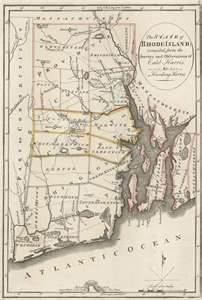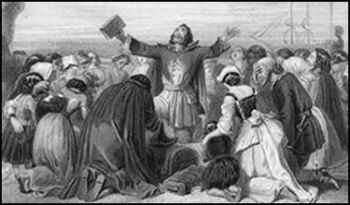The Making of the 50 States: Rhode Island
Part 1: In the Beginning Rhode Island was the last of the original 13 Colonies to ratify the Constitution.
Verrazzano described the island as about the size of Rhodes, a Greek island, and the name stuck. The area proved a popular destination for explorers searching for the Northwest Passage. None of those explorers stayed, of course, choosing to pursue the discovery of something that (though they didn't know it,) didn't exist. Another famous British explorer, John Smith, visited the area in 1614, on a mission to chart the New England coast. Dutch settlers visited the area as well, on the journey that ended with their settling New Amsterdam.
As was the case in other European settlements, relations with Native Americans were mixed. In Rhode Island, as elsewhere, things turned violent in 1675, with King Philip's War resulting in a decisive victory of British settlers over Narragansett warriors. Another result was a series of border treaties with neighboring Connecticut and Massachusetts, allowing Rhode Island to thrive, trading with other colonies and with settlements in Africa, Europe, and the West Indies. Also at this time, Rhode Island relied on a fair amount of slave labor to power its growing farm and fishing industries. This lasted for some time; the colony, however, passed one of the first anti-slavery laws on the continent, in 1774, and an emancipation act in 1784. Next page > The Rest of the Story > Page 1, 2
|
|
Social Studies for Kids
copyright 2002–2024
David White



 What is now Rhode Island was settled originally by mainly four Native American tribes: the Narragansett, the Wampanoag, the Niantic, and the Nipmuck. The Narragansett were by far the most active and prevalent. Members of all four tribes were in various states of thriving when the Italian navigator Giovanni da Verrazzano arrived in 1524, at what is now Block Island.
What is now Rhode Island was settled originally by mainly four Native American tribes: the Narragansett, the Wampanoag, the Niantic, and the Nipmuck. The Narragansett were by far the most active and prevalent. Members of all four tribes were in various states of thriving when the Italian navigator Giovanni da Verrazzano arrived in 1524, at what is now Block Island.  Settlers from Massachusetts' Plymouth Colony began trade with the local Native Americans, but it wasn't until 1635 that the first European settler, William Blackstone, arrived and not until 1636 that Providence, the first settlement, sprang up, under the guidance of religious separatist
Settlers from Massachusetts' Plymouth Colony began trade with the local Native Americans, but it wasn't until 1635 that the first European settler, William Blackstone, arrived and not until 1636 that Providence, the first settlement, sprang up, under the guidance of religious separatist 
